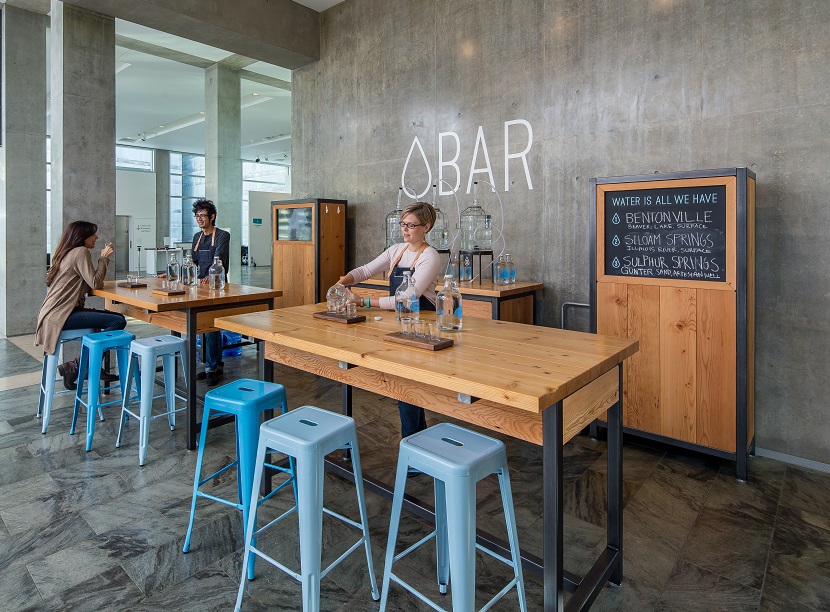
Works Progress
Water Bar, State of the Art exhibition, Crystal Bridges Museum of American Art, Bentonville, Arkansas, 2014.
As a part of the State of the Art: Discovering American Art Now exhibition, Crystal Bridges Museum of American Art is collaborating with the Illinois River Watershed Partnership to spotlight regional water sources. State of the Art, on view until January 19, 2015, features 102 artists from all over the country with 227 works that offer a glimpse into American art and culture right now.
Just inside the lobby of Crystal Bridges and across from the museum’s popular Coffee Bar, visitors find Water Bar, created by the Minneapolis-based art collective Works Progress, (husband and wife duo Colin Kloecker and Shanai Matteson). Water Bar represents a partnership between the artists, Crystal Bridges, scientific researchers, environmental advocates, public employees, educators, and local residents. The interactive installation invites visitors to sample and compare water from three local sources: Beaver Lake (Bentonville), the Illinois River (Siloam Springs), and an artesian well in Sulphur Springs. The “bar” is staffed by eight interns from the Illinois River Watershed Partnership (IRWP) who engage in conversations about where the drinking water comes from and other watershed issues.
“Works Progress uses place, design, and the shared experience of drinking water to focus our attention on local water ,” said Crystal Bridges Curator Chad Alligood. “The collaboration with Works Progress and the Illinois River Watershed Partnership represents a convergence of art and advocacy that engages the community in conversations about an issue that affects all of us.”
The interns staffing the Water Bar come from several educational institutions: four from the University of Arkansas, three from Northwest Arkansas Community College, and one graduate of the University of the Ozarks. They also come from a surprising variety of educational disciplines including environmental science, sustainability, biological engineering, architectural studies, and marketing.
Nathan Sorey, a junior at the University of Arkansas studying environmental science and water quality, is one of the interns working with the IRWP. “I’ve talked to artists, politicians, and business people,” Sorey said. “It’s interesting because we all have this one thing in common: everybody has to have water. My favorite thing about Water Bar is interacting with different people from all over the world and hearing their perspectives on water and life.”

A server at the Water Bar by State of the Art artists Works Progress.
“We can’t create water, we can’t manufacture it, we have to get it from nature. Even if you’re in business, you need to be thinking about your impact on the environment,” said Delia Haak, Executive Director of the IRWP. “Art helps us see things in a different way. There’s a lot of beauty in our watershed and artists are able to capture that.”
The results of the Water Bar conversations and connections made at the Water Bar accumulate in the form of written reflections by visitors, photos shared on social media, commentary on current events, and other documentation gathered by Works Progress and collaborators. At the end of the installation of Water Bar, a document will be produced to convey those conversations and connections to a wider audience, including policy makers, public educators, and water resource scientists. At the conclusion of State of the Art, Water bar will live on in the community through Crystal Bridges in partnership with IRWP.
Works Progress will return to Crystal Bridges for the State of the Art Symposium on November 14-15, 2014, to talk about how they engage artists, designers, organizers, and creative professionals to realize public art rooted in place and purpose. There is also an opportunity for artists, scientist, and water advocates to gather for a reception at IRWP Watershed Sanctuary & Learning Center, November 13th, 2014 from 6 to 8 pm.
State of the Art opened September 13, 2014, and runs through January 19, 2015, with complimentary admission sponsored by Walmart and Sam’s Club.
About Illinois River Watershed Partnership
The Illinois River Watershed Partnership is a collaborative effort between cities and corporations throughout the region to educate people about the watershed, monitor water quality, and perform conservation and restoration projects. The watershed for the Illinois River encompasses hundreds of streams, springs, and creeks over a broad swath of Northwest Arkansas, including half of Bentonville, all of Rogers and Springdale, 60 percent of Fayetteville and everything west of there.



